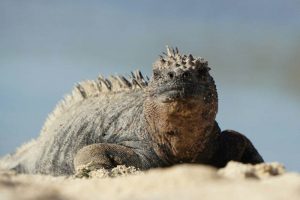An Off-Setting Adventure: Cruising the Galapagos with a Carbon-Neutral Conscience

Hundreds of marine iguanas huddle in a great sprawling mass, oblivious to visitors snapping photographs. The large gray reptiles blend with the stark volcanic scenery of Fernandina, one of the 13 major Galapagos Islands. The iguanas cover nearly every square foot of land—warming in the sunshine, then entering the ocean to feed, emerging with algae-smeared lips. A few dig burrows in the sand to lay eggs. “This is the only island where I say, “Please don’t step on the iguanas!”” says naturalist guide Karina Lopez, a native Galapagueño. Then everyone goes quiet. All of the marine iguanas under the bush are sneezing. They sneeze to rid their systems of saltwater, Lopez explains.
Emission-Free Travel
The promise of close wildlife encounters draws many to this volcanic archipelago some 600 miles west of mainland Ecuador, the nation to which the islands belong.
All Galapagos tours allow visitors to see its famously friendly wildlife, but our group cruised with Ecoventura because of the company’s Earth-friendly policies. Ecoventura is one of only seven cruise companies certified by Smart-Voyager—a program run by Rainforest Alliance and the Ecuadorian group CCD giving a “green seal of approval” to Galapagos tourism operators. In June 2006, Ecoventura went one step further, becoming the only Galapagos cruise—and the first in South America—to go carbon neutral.
The New York Times dubbed “carbon neutral” last year’s buzzword. It means counterbalancing one’s greenhouse gas emissions—generated by any energy use—by investing in environmental energy projects. So far, only a handful of travel companies offset their emissions without passing the cost to the consumer. But, concerned that people might cut out traveling altogether, the mainstream tourism industry has started thinking “cool.” The Caribbean Tourism Organization has begun exploring ways to reduce energy use and initiate carbon-offsetting programs. Australia-based Clean Cruising became the world’s first carbon-neutral travel agency in 2007, offsetting emissions for all cruises—including Australia, Alaska, the Med-iterranean, Antarc-tica and the South Pacific. But Ecoventura was one of the first.
“We wanted to become a trendsetter,” explains Santiago Dunn, Ecoventura’s president. The company analyzed its carbon footprint—the emissions from all cruises, four worldwide offices and company business travel—and found it added up to 3,687 tons of carbon dioxide per year.
Ecoventura offset its emissions with three projects run by the Carbon Neutral Com-pany: a solar energy project in India, tree planting in Chiapas, Mexico and methane capture at a Pennsylvania coal mine. In mid-2007, the company switched its offsets to NativeEnergy.
Some criticize carbon offsetting as buying permission to pollute. Yet emissions are ongoing from the huge fleet (planes, buses, cars, trains) in today’s travel industry, and carbon neutrality proactively counters global warming by funding projects that would not otherwise happen.
Ecoventura analyzes its carbon footprint yearly, with an eye to energy conservation in addition to offsetting. It also encourages onboard recycling, provides customers with biodegradeable soap, uses bacteria-based cleaning products and lead- and TBT-free paint. “I thought we could be part of the solution instead of part of the problem,” says Dunn.
Do It Yourself?
Travelers can offset their own flights and cruises using a retail offset provider, but how do you verify their credentials? In December 2006, the nonprofit group Clean Air, Cool Planet released the first review of offset providers, naming the best eight of 30. The providers who demonstrated the highest commitment to their carbon offset project quality, among other criteria, were AgCert/Driving Green, atmosfair, Carbon Neutral Company, Climate Care, Climate Trust, co2balance, NativeEnergy, and Sustainable Travel/MyClimate.
While an increasing number of travel companies offer ecotourism opportunities, few offset their carbon footprint like Ecoventura. It matches the deeply felt environmental ethic that pervades the Galapagos Islands—a place that represents not just evolution, but also endangered wildlife in a stark and hauntingly beautiful landscape.
The Galapagos’ unique wildlife helped Darwin develop the theory of natural selection, and many species, including Darwin’s finches, live nowhere else in the world. Land exploration brings visitors close to giant tortoises, land iguanas, lava lizards, blue-footed boobies, and lounging Galapagos sea lions and fur seals. And unbeknownst to many, the ocean here offers a rare warm-water opportunity to snorkel with penguins, as well as sea lions, sharks, manta rays, chocolate chip sea stars and hundreds of colorful fish. Others will likely follow in Ecoventura’s pioneering “cool” footsteps, in the Galapagos and around the world.
WENDEE HOLTCAMP is a Texas-based environmental writer.

